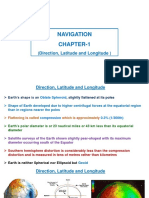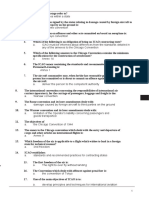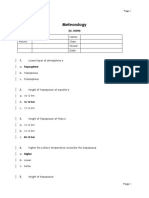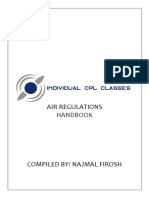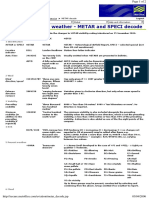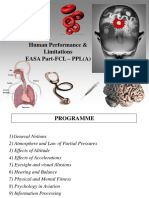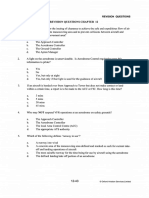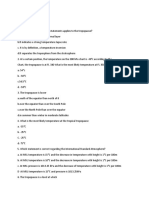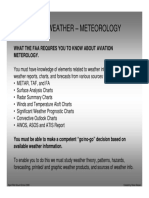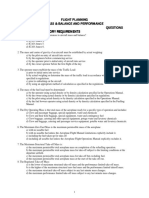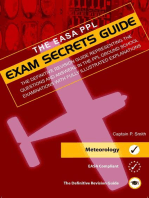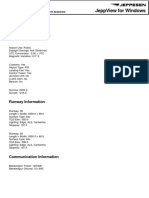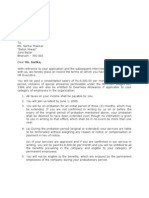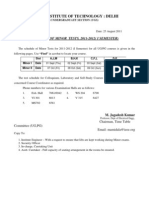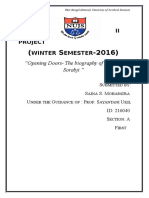CPL Notes-Meteorology
CPL Notes-Meteorology
Uploaded by
uzairazizsuria1Copyright:
Available Formats
CPL Notes-Meteorology
CPL Notes-Meteorology
Uploaded by
uzairazizsuria1Copyright
Available Formats
Share this document
Did you find this document useful?
Is this content inappropriate?
Copyright:
Available Formats
CPL Notes-Meteorology
CPL Notes-Meteorology
Uploaded by
uzairazizsuria1Copyright:
Available Formats
Page 1 of 27
COMMERCIAL PILOT EXAM
METEOROLOGY NOTES
(TWENTY STRONG PAGES)
A dedication to our teacher & mentor, CAPT. QAISER ANSARI,
The Foundation of Knowledge – The Aviation Encyclopedia.
Compiled by Capt Khilji A.K - 3693
Page 2 of 27
1. BUYS BALLOTS’S LAW ........................................................................................................ 4
2. FRONTS.................................................................................................................................... 4
WARM FRONT ...................................................................................................................................................................................... 5
Cross section ................................................................................................................... 5
WARM SECTOR .................................................................................................................................................................................... 6
COLD FRONT ........................................................................................................................................................................................ 6
Cross section ................................................................................................................... 6
OCCLUDED FRONT ............................................................................................................................................................................. 7
Cross section ................................................................................................................... 8
3. CLOUDS ................................................................................................................................... 8
HIGH 9
MEDIUM ................................................................................................................................................................................................. 9
LOW 9
FORMATION OF CLOUDS ............................................................................................................................................................... 10
Convection .................................................................................................................... 10
Orographic uplift. .......................................................................................................... 10
Cloud formed by turbulence and mixing......................................................................... 10
Cloud formed by widespread lifting................................................................................ 10
CLOUDBASE ....................................................................................................................................................................................... 11
4. CONVECTION ....................................................................................................................... 11
THERMAL PRODUCTION ................................................................................................................................................................ 12
THE “REAL ATMOSPHERE” ............................................................................................................... 12
Inversion ....................................................................................................................... 12
STABILITY AND INSTABILITY ...................................................................................................................................................... 13
CUMULUS CLOUD FORMATION................................................................................................................................................... 13
5. METEOROLOGICAL TERMS ............................................................................................. 16
6. PRESSURE SYSTEMS .......................................................................................................... 16
LOW PRESSURE ................................................................................................................................................................................. 17
Formation of a low ........................................................................................................ 17
Associated weather ........................................................................................................ 18
HIGH PRESSURE ................................................................................................................................................................................ 18
Associated weather ........................................................................................................ 19
7. WINDS AND THINGS ........................................................................................................... 19
VALLEY WINDS ................................................................................................................................................................................. 19
SEA BREEZES ..................................................................................................................................................................................... 21
SEA BREEZE FRONTS....................................................................................................................................................................... 21
WAVE LIFT.......................................................................................................................................................................................... 21
FOG 21
Radiation fog................................................................................................................. 21
Advection fog................................................................................................................. 22
Sea fog .......................................................................................................................... 22
Hill Fog......................................................................................................................... 22
8. SYNOPTIC CHART............................................................................................................... 22
9. CLOUDS AND RAIN ............................................................................................................. 24
Compiled by Capt Khilji A.K - 3693
Page 3 of 27
List of figures:
FIGURE 1 LOW PRESSURE SYSTEM ................................................................................................................................................ 4
FIGURE 2 WARM FRONT SYMBOL ................................................................................................................................................. 5
FIGURE 3 WARM FRONT CROSS-SECTION .................................................................................................................................. 5
FIGURE 4 COLD FRONT SYMBOL ................................................................................................................................................... 6
FIGURE 5 COLD FRONT CROSS-SECTION .................................................................................................................................... 6
FIGURE 6 ANAFRONT ......................................................................................................................................................................... 7
FIGURE 7 KATAFRONT ...................................................................................................................................................................... 7
FIGURE 8 OCCLUDED FRONT SYMBOL ........................................................................................................................................ 8
FIGURE 9 OCCLUDED FRONT CROSS-SECTION ......................................................................................................................... 8
FIGURE 10 CLOUD TYPES ................................................................................................................................................................. 9
FIGURE 11 CLOUDS FORMED BY TURBULENCE .................................................................................................................... 10
FIGURE 12 STANDARD ELR ............................................................................................................... 11
FIGURE 13 ELR AND DALR .............................................................................................................. 12
FIGURE 14 INVERSIONS .................................................................................................................................................................. 13
FIGURE 15 CONVECTIVE CLOUD FORMATION ....................................................................................................................... 14
FIGURE 16 SAMPLE QUESTION ELR .................................................................................................... 15
FIGURE 17 SAMPLE QUESTION ELR AND DALR .................................................................................. 15
FIGURE 18 SAMPLE QUESTION ELR, DALR AND SALR ...................................................................... 15
FIGURE 19 FORMATION OF LOW PRESSURE ............................................................................................................................ 17
FIGURE 20 FORMATION OF LOW (1) .................................................................................................... 17
FIGURE 21 FORMATION OF LOW (2) .................................................................................................... 18
FIGURE 22 FORMATION OF LOW (3) .................................................................................................... 18
FIGURE 23 VALLEY WINDS (MORNING) ............................................................................................... 19
FIGURE 24 VALLEY WINDS (MIDDAY) ................................................................................................. 20
FIGURE 25 VALLEY WINDS (EVENING) ................................................................................................ 20
FIGURE 26 SEA BREEZE FRONT ................................................................................................................................................... 21
FIGURE 27 ADVECTION FOG ........................................................................................................................................................ 22
FIGURE 28 SYNOPTIC CHART ....................................................................................................................................................... 23
FIGURE 29 ROTATION ROUND PRESSURE SYSTEMS ............................................................................................................. 23
FIGURE 30 SURFACE WIND ROUND A LOW.............................................................................................................................. 24
FIGURE 31 SURFACE WIND ROUND A HIGH............................................................................................................................. 24
Compiled by Capt Khilji A.K - 3693
Page 4 of 27
Meteorology
1. Buys Ballots’s Law
Very Simple - this states that in the Northern Hemisphere, if you stand with your back to the wind,
the area of low pressure is on your left hand side. In the Southern Hemisphere, it is on your right hand
side.
2. Fronts
A front is a boundary between 2 different air masses of different density. Air masses don’t like to mix
and the boundary between the two (the front) is where active weather can take place. Fronts are very
common in depressions.. Although not in the syllabus, a depression starts along the jet stream.
The jet stream is an area of very fast moving air; West to East (in the Northern Hemisphere). The jet
stream is like the traffic on a motorway; it sometimes bunches and sometimes eases off. Where it
bunches, the high altitude pressure increases causing a downward flow of air - thestart of an
anticyclone (high pressure system) where it eases, it speeds up and due to Bernoulli’s principle, it
causes a reduction in pressure - the start of a low. More details later. As the low pressure “winds up”,
it twists the air masses and causes the characteristic low with fronts. The formation of a low with its
frontal systems will be explained in the section on Pressure systems.
For this section, the typical low with frontal zones is shown below;
Figure 1 Low pressure system
Warm Front
A warm front is where warm air overrides cooler air. Shown on maps as;
Figure 2 Warm front symbol
Compiled by Capt Khilji A.K - 3693
Page 5 of 27
A warm front is where an area of warm air catches up with an area of cold air and overrides it (due to
the less density). The normal warm front has a shallow slope with the air rising gradually over many
hundreds of miles. This lifting produces the gradually thickening layer of cloud which eventually
results in the steady rain near the frontal zone.
Cross section
The cross section of a warm front is shown below;
Figure 3 Warm front cross-section
The normal warm front has a shallow slope as the warm air mass overrides the cooler air. The
slope is typically 1:50 to 1:400 and the frontal zone effect may extend 500 miles ahead of the
frontal transition on the ground. This means that the forthcoming warm front may be seen in
advance. High cloud such as Cirrus and Cirrostratus will shut off the solar activity usually
cutting off thermals. Then the cloudbase will lower with Alto stratus and Nimbostratus giving
drizzle as the front approaches. Rain possibly beginning 5-10 hrs before the passage of the
front. The winds may strengthen and 1back. At the front, the rain eases off, the wind will veer
50 degrees or so and the temperature and humidity will rise. We are now in the warm sector.
Warm Sector
The warm sector is the area between the leading warm front and its following cold front. The air is
warm and produces the right conditions for wave flights. Following the warm sector ids the cold front.
1
back - winds change direction ANTI CLOCKWISE
Compiled by Capt Khilji A.K - 3693
Page 6 of 27
Cold Front
A cold front is where colder denser air undercuts warmer air. It is shown on maps as below;
Figure 4 Cold front symbol
When a mass of cold air meets a mass of warm air, it tries to undercut it. The cold air pushes under
the warm air acting as a wedge. The slope of the wedge is steep, about 1 in 30 to 1 in 100. They move
quickly about 20mph. and strong updraughts can be produced about 100 miles ahead of a front.
Cross section
The cross section is shown below;
Figure 5 Cold front cross-section
The warm sector gets its name from the fact that the cold front usually follows a warm front.
See the section on pressure systems later.
The cold front is often dramatic with heavy showers. At the front, the temperatures drop, the
air is drier and the wind 2veers often to the North West direction. Behind the cold front, there
is often a complete clearance of cloud but this very quickly gives way to high Cumulus and
2
veer - winds change direction CLOCKWISE
Compiled by Capt Khilji A.K - 3693
Page 7 of 27
shower clouds. Good days for soaring are found after cold fronts have gone through and the
pressure starts to rise again. The rising pressure raises cloudbase, and the cooler air means a
ready supply of thermals.
Occluded Front
An occluded front is where a cold front has caught up with a warm front. It is shown on maps as
below;
Figure 8 Occluded front symbol
As the depression deepens, the cold front with its weather systems catches up with the warm front and
the 2 types of weather become mixed.
Cross section
Figure 9 Occluded front cross-section
The occlusions can have some of the characteristics of a warm front or a cold front but on a
milder scale. The weather produced by a occlusion can range from that of the 2 frontal types to
prolonged periods of rain.
Compiled by Capt Khilji A.K - 3693
Page 8 of 27
3. Clouds
The amount of moisture that air can hold depends on its temperature, with warmer air holding more
air than cold.
Cloud form whenever the air is cooled to a point where the temperature to which a particular mass of
air must be cooled for saturation to occur is called the Dew Point.
Sometimes the amount of moisture in the air is measured as relative humidity. The Relative humidity
(RH) is;
RH = amount of water vapour in the air / amount of water vapour required to saturate it (at that
temperature). This is expressed as a percentage.
i.e. dry air has a RH of 0%. Air about to form cloud has a RH of nearly 100%.
Clouds are classified as high, medium or low according to the height of their base. There are 10 basic
types. See the diagram below;
Figure 10 Cloud types
High
Altitude range is 15 to 40,000ft. These are composed mainly of ice crystals and are known as cirro
types.
1. Cirrus (Ci) is the wispy high cloud
2. Cirrocumulus (Cc) is a high cloud with a cell pattern.
3. Cirro stratus (Cs) is the thin veil type cloud
Medium
Altitude range is 6,500 to 23,000ft. The are known as alto clouds.
4. Alto cumulus (Ac) is a medium layer with a cell pattern. In an unstable atmosphere, Ac may
produce virga or precipitation which does not reach the ground.
Compiled by Capt Khilji A.K - 3693
Page 9 of 27
5. Alto stratus (As) is an even layer of cloud at medium height
Low
Altitude range is 0 to 8,000ft.
6. Nimbostratus (Ns) is a deep layer of rain cloud.
7. Stratocumulus (Sc) is a greyish/whitish cloud consisting of rolls or cells. The weather is light rain,
drizzle or snow.
8. Stratus (St) is a low lying layer of cloud. May give drizzle
9. Cumulus (Cu) these are individual heaped clouds with a cauliflower top. Large Cu may give
showers.
10. Cumulonimbus (Cb) are heavy shower clouds or thunderstorm clouds. The tops of these can reach
past 30,000ft. Weather is rain, hail and heavy showers.
There are other clouds which are not listed above –
Castellanus such as Altocumulus castellanus are excellent indicators (especially in the Alps) or upper
atmosphere instability. These in the morning may indicate Cbs later in the day.
Lenticular - These lens shaped clouds indicate the presence of wave activity and may be stacked, one
above the other in certain cases. They show the top of the wave.
Formation of clouds
Clouds may be formed in several ways but all rely on the fact that the air is cooled to a point where it
cannot hold its moisture.
Convection
The action of the sun will heat the ground. This in turn heats the air layer closest to the ground
which will become warmer and thus less dense. It may rise and is it does so, it will cool.
Eventually it may reach a point where its temperature reaches the dew point and the water
vapour condenses to form cloud. Cumulus cloud is formed in this way.
Orographic Uplift
Air may be flowing along and be forced to rise upwards when it reaches an obstruction such as
a mountain chain. As it rises it will cool and it may be cooled past its dew point temperature. It
will condense and orographic cloud will form on the windward side of hills.
Cloud formed by turbulence and mixing
As air flows over the surface of the earth, frictional effects cause variations in local wind
strengths. Eddies are set up which cause the lower level air to mix. The more friction and
stronger the wind, the more mixing it causes. As the air mixes, it may rise and if it cools
enough, layer cloud above the friction area may result.
Compiled by Capt Khilji A.K - 3693
Page 10 of 27
Figure 11 Clouds formed by turbulence
Cloud formed by widespread lifting
When two air masses meet, such as in a warm front, then great areas of air may flow over the
cooler air and rise as it does so. High stratus cloud will result. See the section on fronts for more
details.
Cloudbase
Cloudbase is the term given to indicate the height that the base of the cloud is ASL. It can be
calculated from the dew point and the ground temperature.
Cloudbase in feet = (Air temp - dew point) x 400.
i.e. Temp of 23 deg with dew point of 12 give a cloudbase of 4,400ft.
4. Convection
One of the main topics in the Met course is to describe thermal growth and activity. By understanding
this and the reasons for thermals, we can also understand many other parts of the atmosphere and
cover such things as, Inversions, Stability and instability, Cb’s and cloud base.
With increasing altitude, the following decrease -
Temperature
Pressure
Density
As altitude rises, temperature generally decreases. This change in temperature with height is called
the Lapse Rate.
The standard atmospheric rate of change has been defined by Scientists as the standard atmosphere
and it has the following conditions;
Environmental Lapse rate (ELR) = 2’C/1000ft
Pressure change = 1mb per 30ft
The ELR can be represented on a graph but it is important to know that this is only a “measuring
stick”. The real ELR may be a lot different.
.
Compiled by Capt Khilji A.K - 3693
Page 11 of 27
Altitude (ft)
Standard ELR
5,000ft
10 20 Temperature (degrees C)
Figure 12 Standard ELR
Compiled by Capt Khilji A.K - 3693
Page 12 of 27
Thermal production
As the sun heats the ground, the ground in turn heats up a layer of air close to the ground. A bubble of
warm air starts to form and is less dense than the surrounds since it is warmer. It may unstick from
the ground and start to rise through the atmosphere. As the density and the pressure of the
surrounding air decreases with altitude, the thermal will expand 3adiabatically and hence it cools. As
air expands it cools. The thermal will cool at a known rate and its rate of cooling or lapse rate is the
Dry Adiabatic Lapse rate or DALR. The word dry refers to the moisture in the thermal being retained
as vapour and not condensing.
Dry adiabatic lapse rate (DALR) = 3’C / 1000ft
If we plot the course of a thermal leaving the ground with a temperature of 25’C, after 5,000ft the
thermal has cooled to 10’C and has reached equilibrium with the surroundings. i.e. it stops rising.
Altitude (ft)
Standard ELR
5,000ft
DALR
Ground heating of
Surface air
10 20 25 Temperature (degrees C)
Figure 13 ELR and DALR
The “Real Atmosphere”
In real life, the atmospheric conditions do not look exactly like the above. Overlaying warm fronts
could mean warm air aloft. High pressure systems could warm the upper air due to compression of the
upper air. Air close to the ground may be chilled on a clear night. When the air temperature does not
fall with height, but rises, then this condition is called an inversion.
Inversion
An inversion is a warming of the air at height increases and can be in 2 types.
High level - caused by a high pressure system warming the upper air
3
An adiabatic process is one where no heat is lost from gained from the surroundings.
Compiled by Capt Khilji A.K - 3693
Page 13 of 27
Low level - caused by air chilled in contact with a cold ground which has lost heat by
convection
These may be shown on a lapse rate graph as before;
Altitude (ft)
High level inversion
5,000ft
Ground
Inversion
10 20 25 Temperature (degrees C)
Figure 14 Inversions
Inversions may puts a lid on our max. altitude possible by thermals.
Stability and instability
We often hear the terms stability and instability with the latter being our preference. Using the lapse
rate graphs we can understand the terms. Thermals will rise to a point where they are in equilibrium
with the surrounding. If the ELR is such that the equilibrium is never reached, then the thermals will
keep rising indefinitely. i.e. the 2 lines diverge. This is unstable.
If the 2 lines converge, then the day will be relatively stable.
Unstable ELR > DALR (3’C/1000ft)
Stable ELR < DALR (3’C/1000ft)
Cumulus cloud formation
A thermal rising will may contain moisture. As they rise, they cool and may rise to a point where they
reach the dew point. At that, the water vapour condenses to form cloud. We have reached cloudbase.
As the water condenses, something else happens. Latent heat will be released. The latent heat is the
extra energy required when a substance changes state, i.e. from water to water vapour, extra heat is
required to effect the change of state. This extra heat is stored and released when the water vapour
condenses back into a liquid. This in effect gives a “boost” to the thermal and acts as a source of heat,
hence the lapse rate in clouds will be lower than in a dry thermal. The lapse rate in clouds is known
as the Saturated (or moist) adiabatic lapse rate) SALR.
This has a range of values depending on the moisture content but is typically;
Saturated Adiabatic lapse rate (SALR) 1.1 - 2.8’C/1000ft
Compiled by Capt Khilji A.K - 3693
Page 14 of 27
The thermal in a cloud will keep rising until an inversion is reached or the cloud runs out of moisture.
This determines the cloud top height. If the air mass is very unstable and there is a constant supply of
warm moist air and powerful thermal development, then the situation may turn be right for the
formation of Cunimbs (Cb) .
The trigger temp is the temperature on the ground at and beyond which thermals will rise past the
inversion layer.
Different ground types absorb solar energy better than others as far as thermal production is caused.
The thermal is caused by the sun heating the ground (not the air itself), then the ground will warm up
the bottom layer of the air to warm a “warm bubble” which wants to rise up. Dark surfaces such as
ploughed fields, areas of dark tarmac are better than lakes etc, for the production of a thermal. The
exam will expect you to be able to plot the life of a thermal.
Lets look at a typical thermal growth on a lapse rate graph.
Altitude (ft)
Cloud tops
SALR
Cloudbase
DALR
10 Dew 20 25 Temperature (degrees C)
Point
Figure 15 Convective cloud formation
On the day above, clouds have formed with the cloudbase at dew point and the cloud tops limited by a
lack of moisture, or if there is an abundant supply of moisture, then the inversion above. Note that if
the dew point had been lower, then the thermal would have risen as a blue thermal (no cloud) and
could have possible been cut off lower. The SALR has a steeper gradient and thus is very unstable.
Knowledge of ELR, DALR and SALR and the effect on thermals together with dewpoint and the
effect on clouds is required for the exam (hint). One other term to know is the Isothermal layer. This
is an area of the atmosphere where the temperature does not change with height.
Lets take an example question.
A table showing air temperature against height is below. Dewpoint at ground is 14’C and decreases
by 0.5’C per 1,000ft. SALR is 1.5’C per 1,000ft. Describe what happens.
Compiled by Capt Khilji A.K - 3693
Page 15 of 27
The ELR is plotted below with the dewpoint shown as a dotted line.
Height Air temperature
0 24 9000
1000 17 8000
2000 15
7000
3000 13
4000 11 6000
5000 9 5000
6000 7 4000
7000 8
3000
8000 7
9000 6 2000
1000
0
6 7 8 9 10 11 12 13 14 15 16 17 18 19 20 21 22 23 24
Figure 16 Sample question ELR
9000
8000 The thermal leaves the ground
with a temp of 24’C and rises at
7000
the DALR.
6000
5000
4000
3000
2000
1000
0
6 7 8 9 10 11 12 13 14 15 16 17 18 19 20 21 22 23 24
Figure 17 Sample question ELR and DALR
Then plot the air rising at the 9000
SALR of 1.5’C/1000ft after the
8000
thermal has hit the dewpoint.
7000
6000
The SALR hits the inversion (in
5000
this case) at about 6,600ft, the
cloud tops are limited by the 4000
inversion to about 6,600ft. Cloud 3000
base is 4,000ft which ties in with
2000
the equation. Note the reliability
of the equation is based on the 1000
DALR of 3’C and the dewpoint 0
lapse rate of 0.5’C per 1,000ft. 6 7 8 9 10 11 12 13 14 15 16 17 18 19 20 21 22 23 24
Figure 18 Sample question ELR, DALR and SALR
Compiled by Capt Khilji A.K - 3693
Page 16 of 27
If the air is very moist and the SALR is less than 1.5, then the possibility exists of the moist air rising
at a steeper gradient and therefore escaping the effects of the inversion and high Cu’s or Cb’s may
result.
5. Meteorological terms
Adiabatic - A thermodynamic process where Iso - equal
no heat leaves or enters the system
Iso therm - a line of constant temperature
Advection - transfer of air mass properties by
motion. Katabatic wind - wind that flows downslope
Air mass - huge body of air in which Katafront -a front where the warm air sinks
horizontal changes in temp are small. down above the frontal surface which will
eventually weaken and destroy the front.
Anabatic wind - Wind blowing upslope.
SALR - Saturated adiabatic lapse rate,
Anafront - a front where warm air is about 1.5°C per 1000ft
ascending over cold air.
Stability - the tendency of the atmosphere to
Anticyclone - area of high pressure stay as it is. Unstable air, where the ELR is
greater than the DALR (in excess of 3°C per
Backing - winds changes direction anti 1000 ft) means that a thermal will diverge
clockwise from the atmospheric temperaturelapse rate.
Convection - transfer of heat by motion of a Standard atmosphere (ISA) has a ELR of 2°C
substantial volume of air. per 1000ft
Dew point - temperature at which air must be Super Adiabatic Lapse Rate - A lapse rate
cooled to become saturated with water vapour. greater than 3°C per 1000ft
DALR - Dry Adiabatic lapse rate, about 3°C Tephigram - a aerological diagram with the
per 1000ft x.y co-ordinates Temperature and entropy.
The diagram is used for plotting the values of
ELR - Environmental lapse rate. This is 2°C temp and humidity at specific pressure levels
per 1000ft for the ISA. obtained from upper air soundings.
Inversion - a layer of air where the Veering - wind which changes
temperature increases with height. direction clockwise.
6. Pressure systems
As the earth is covered by atmosphere, this atmosphere exerts a pressure on us all. This pressure is
measured in Bars and the pressure is about 1 bar. A bar is too large for any detail so it is divided into
millibars and represented as 1000mb. The unit hectopascal may also be used and is the same as a
millibar.
Compiled by Capt Khilji A.K - 3693
Page 17 of 27
Low pressure
Low pressure systems are the source of a great deal of active weather in the UK. The majority of our
weather systems form out in the Atlantic along the frontal boundary between the arctic airmass and
the warmer tropical maritime air to the south.
Formation of a low
When 2 masses of air of different density lie side by side they induce a strong current of air to
flow along the cold side of the front at very high altitudes. This jet stream is formed due the
extreme pressure differences at altitude causing a close bunching if high altitude isobars. The
jet is several miles deep and travels at speeds of about 100 to 200 mph. Disturbances cause the
jet tosnake around and results in areas of divergence and convergence.
Jet stream
Cold air
Warm air
Area of Area of
Convergence Divergence
pressure rises pressure falls
Figure 19 Formation of low pressure
The area of convergence will cause downward flowing air. This results in an increase in
pressure at ground level and a downward movement of air. Similarly, at the area of divergence,
the surface pressure will fall and an area of low pressure will start to form.
1. The jet stream divergence will cause an area of low pressure to start to form along the
frontal zone.
The low pressure will draw the 2 edges of
the front together, effectively increasing
the temperature and pressure differentials
thus aiding the formation of the low.
Figure 20 Formation of low (1)
Compiled by Capt Khilji A.K - 3693
Page 18 of 27
As the air rises it is given a twist by the Coriolis
force. This coriolis force is exactly the same as the
force which causes the water going down the
plughole to spin. The force is zero at the equator
and is the reason behind low pressure spinning anti
clockwise in the Northern hemisphere and the
Figure 21 Formation of low (2) reverse in the southern hemisphere.
As the air in continually extracted at the top
of the system, so the surface pressure drops
increasing the circulation and the winds
speeds. The anticlockwise circulation is
gradually spread up to the upper levels and
the upward movement of ward moist air
will eventually cause condensation and the
release of latent heat to further power the
process.
The cold front moves faster than the warm
front and catches it up. With an occlusion
forming where the cold front has caught the
warm front The spiralling air in the
depression further twists the fronts round to
give the classic “hook” shape of the
depression.
Figure 22 Formation of low (3)
Associated weather
The weather associated with a depression is usually poor. Associated frontal systems can bring rain
and cloud. A depression may arrive at our shores at any stage of development and it may or may not
have frontal systems. It may have a weak warm front and an active cold front or vice versa. A system
with an active cold and an active warm front is very rare. It may have a decaying occlusion, but the
general outlook is worsening weather.
High pressure
High pressure systems are formed in a similar way to lows, and areas of high pressure can mean areas
where there aren’t any lows. In an anticyclone, the air is descending and being warmed by
compression as it descends. Since warmer air can hold more moisture, then clouds are less willing to
form.
Compiled by Capt Khilji A.K - 3693
Page 19 of 27
This results in clear skies at night and little tendency for any overdevelopment.
Associated weather
In summer, a high pressure system always means an improvement with lighter winds and less
cloud. In winter a high pressure can mean persistent fog and low cloud or it may lead to clear
skies, depending on the source and track of the airmass at low level.
High pressures move slowly and can lead to the production of inversions due to the warmed
upper air. The atmosphere becomes stable (cooler air at the bottom) and leads to poor thermal
production. Inversions can lead to poor air quality with pollen, dust etc. being trapped in the
inversion layer. Highs can persist for days and then they become blocking highs which will
often divert the path of a low pressure system around the UK.
7. Winds & Other Wx Phenomena
Valley winds
Mountains tend to form a barrier to winds at low level. The air tends to flow up and down the valley
Imagine a valley with hills on both sides. In the morning, the effect of the sun is to heat up the
mountains first since the valley will be cooler and still in shade;
Morning
Figure 23 Valley winds (morning)
Compiled by Capt Khilji A.K - 3693
Page 20 of 27
As time reaches midday, both slopes are in sun and powerful anabatic winds are produced up both
slopes
Figure 24 Valley winds (midday)
This causes the winds at low level to rush up the valley to replace the air flowing up the slopes. The
valley wind flows into the valley in the afternoon and evening. As the sun goes down and the slopes
start to cool off with the altitude, katabatic winds flow downslope
Night
Figure 25 Valley winds (evening)
In the evening, as the wind turns katabatic on the slopes, it can rush down the hill and force upwards,
over the valley centre, great areas of lifting air. This is the evening restitution lift or magic lift and
can give easy soaring for quite a while in huge areas of lifting air. As time goes on, the valley winds
will slow down from travelling up the valley and then turn to the evening and night time valley winds
where they flow down the valley.
Sea breezes
In summer, the land tends to warm up quickly, but the sea remains much at the same temperature.
Thermal activity may result in a general lessening of the pressure over the land with the results that
air flows in from the sea to replace the lifting air over the land. This is a sea breeze. It can kill
convection and shut off any thermals near the coast so avoid sea breezes.
In winter, the sea temperatures are relatively stable and warmer than the cold land. The sea breeze is
reversed and sometimes leads to Cumulus formation over the sea as cold land air is blown over the
sea, to have its base warmed by the sea to produce unstable conditions over water.
Sea Breeze Fronts
When a sea breeze sets up, it could be in opposition to the normal wind. In this case, a sea breeze
Compiled by Capt Khilji A.K - 3693
Page 21 of 27
front may be formed. This is characterized by a hanging curtain of cloud and a stepped cloud base.
This is due to the moist sea air having a lower cloudbase. It needs a fairly light wind, warm day and
some instability to set up the sea breeze front. The evidence of a front may also be apparent even with
no surface 4geostrophic wind. The cool moist air flowing inland will meet the warm dry land airmass
and this is also a cold front of sorts.
Figure 26 Sea breeze front
Sea breeze fronts rarely occur between October and April.
Wave lift
Another type of lift is the wave lift. The requirements for wave are;
Wind to be in a fairly constant direction
Wind to be increasing with height
A shallow unstable layer with a stable layer above it works well
An obstruction upwind such as a range of hills is needed to start the waves off
Fog
Fog is cloud on ground level and there are several types
Radiation fog
Conditions suitable for radiation fog are;
A cloudless night, allowing the earth to cool and thereby causing the air in contact with it
to become cool
Moist air that requires little cooling to reach dew point
Light winds to reduce mixing
4
Geostrophic - wind set up parallel to isobars. The “normal” wind
Compiled by Capt Khilji A.K - 3693
Page 22 of 27
Advection fog
A warm moist air mass flowing across a significant colder surface will be cooled from below. Ifits
temperature is reduced to the dew point, then fog will form. Advection fog can persist in stronger winds
than radiation fog.
Figure 27 Advection fog
Sea fog
Sea fog is advection fog and may be caused by
An air flow off a warm land moving over a cold sea.
warm tropical air moving over a cold ocean or meting a cold air mass
Hill Fog
Hill fog is caused when moist air is uplifted over a hill and cools as it is forced upwards. As it cools it
condenses to form hill fog or orographic cloud.
Compiled by Capt Khilji A.K - 3693
Page 23 of 27
8. Synoptic chart
The exam requires you to understand the symbols, isobars, pressure systems and associated weather
that you could expect when checking a synoptic chart.
A typical chart is shown below.
Figure 28 Synoptic chart
Pick out features such as;
Areas of high pressure and low pressure
Isobars
Frontal systems
Remember about the Coriolis force and its effect on both high and low pressure systems
The Coriolis force means that in the Northern hemisphere, the
Geostrophic wind circulates anticlockwise round a low and
clockwise round a Anticlyclone (High pressure). The winds
rotate in the same direction as the isobars, but this is only true
for winds at altitude (over about 1,000ft). The effect of the
ground causes friction which slows down the surface winds.
Figure 29 Rotation round
pressure systems
Compiled by Capt Khilji A.K - 3693
Page 24 of 27
The surface wind around a low pressure points to the low pressure
by about 30’ over land due to the friction. This effect is less over the
sea where the friction is less.
Figure 30 Surface wind
round a low
The surface wind around a high pressure points away from the high
pressure area by again about 30’ due to the friction. The wind speed
also decreases in both cases
Figure 31 Surface wind
round a high
Think of the affects on the atmosphere such as wind speed and direction, temperature, precipitation,
cloud cover and visibility.
By the way, the above chart was taken in January, in the depths of the icy winter. Winds were from
the East (Siberia) and as the base of the winds warmed up slightly over the North Sea, this resulted in
instability with snow showers over the eastern coast and hills. The high pressure fended off any frontal
system and allowed the temperatures to plummet during the evenings. Blocking highs like this can
(and did) last for several days. The chart was taken as the cold weather was dying off. The frontal
systems in the Atlantic did eventually make their way in and the winds switched direction to the West
or South West raising the temperatures and bringing the normal weather of showers, winds etc.
9. Clouds and Precipitation
Rain or precipitation can consist of different types of precipitation. It may be rain, fine drizzle, snow
or hail.
Continuous rain or snow is associated with Nimbostratus and alto stratus clouds and intermittent rain
or snow with Altostratus or Stratocumulus.
Rain and snow showers are associated with cumuliform clouds such as Cumulonimbus, Cumulus and
Altocumulus, with the very heavy showers & thunderstorms coming from the Cumulonimbus.
Fine drizzle and snow is associated with Stratus and Stratocumulus.
Compiled by Capt Khilji A.K - 3693
Page 25 of 27
A
Adiabatic ................................................... 16 M
Advection .................................................. 16 Magic lift .................................................. 20
Advection fog ............................................ 22
Air Mass ................................................... 16 N
Altocumulus (AC) ....................................... 8 Nimbostratus............................................... 9
Altostratus (AS)........................................... 9
Anabatic .................................................... 16 O
Anticyclone ............................................... 16 Occluded Front ........................................... 7
Orographic uplift ….. ............................... ..9
B
Backing ..................................................... 16 P
Bernoulli’s principle .................................... 4 Pressure Systems…………………………..16
Buys Ballots’s Law...................................... 4
R
C
Radiation fog ............................................ 22
Castellanus ................................................ 10 Relative humidity ........................................ 8
Cirrostratus (CS) ......................................... 8 Restitution lift ........................................... 20
Cirrocumulus (CC) ...................................... 8
Cirrus (CI)................................................... 8 S
Cloudbase ................................................. 11 SALR....................................... 13, 14, 15, 16
Cold Front ................................................... 6 Sea breeze fronts ....................................... 21
Convection ................................................ 10 Sea breezes ............................................... 20
Coriolis force....................................... 18, 23 Sea fog ...................................................... 22
Cumulonimbus (CB) .................................. 9 Stability ......................................... 11, 13, 16
Cumulus (CU) ............................................. 9 Strato cumulus ............................................ 9
Stratus(ST) ................................................. 9
D
Synoptic chart ........................................... 24
DALR ................................ 12, 13, 14, 15, 16
Dew point.................................................. 16 T
Dew Point ................................................... 8 Tephigram ................................................ 16
Trigger temp ............................................. 15
E
ELR ................................... 11, 13, 14, 15, 16 V
Valley winds ............................................. 19
Veering ..................................................... 16
F
W
Fog……………………………………….21
Warm Front ................................................ 5
H Warm Sector ............................................... 6
High pressure systems ............................... 18 Wave ........................................................ 21
Hill Fog ..................................................... 22
I
Instability ........................... 10, 11, 13, 21, 24
Inversion ............................................. 12, 16
Isothermal layer ......................................... 14
J
Jet stream .............................................. 4, 17
L
Lapse Rate ................................................ 11
Lenticular .................................................. 9
Low pressure systems ................................ 17
Compiled by Capt Khilji A.K - 3693
You might also like
- 022 Instrumentation (922 Soru)Document151 pages022 Instrumentation (922 Soru)Barış Çiçek80% (5)
- CPL Navigation NotesDocument99 pagesCPL Navigation NotesWafs James100% (2)
- Fuel ExercisesDocument6 pagesFuel ExercisesNicolas Cuvelier100% (1)
- PPL Exam Secrets Guide - Aviation Law & Operational ProceduresFrom EverandPPL Exam Secrets Guide - Aviation Law & Operational ProceduresRating: 4.5 out of 5 stars4.5/5 (3)
- Strategy Implementation GqCSbajLjcDocument5 pagesStrategy Implementation GqCSbajLjcKAVYA MAHESHWARINo ratings yet
- Instruments Keith WilliamsDocument92 pagesInstruments Keith WilliamsPreet GonsalvesNo ratings yet
- Navigation Chapter-1: Direction, Latitude and LongitudeDocument76 pagesNavigation Chapter-1: Direction, Latitude and LongitudeAnusher Ansari100% (1)
- Atpl Meteorology First 3 Chapter Summary OXFORDDocument8 pagesAtpl Meteorology First 3 Chapter Summary OXFORDmigoyaNo ratings yet
- Examen MeteorologiaDocument185 pagesExamen MeteorologiaYuvaraj UdayagiriNo ratings yet
- 050 Human Performance - Limitations (906 Soru)Document131 pages050 Human Performance - Limitations (906 Soru)Barış ÇiçekNo ratings yet
- RTFQ Question Bank Entrance Test-AirlinesDocument22 pagesRTFQ Question Bank Entrance Test-AirlinesRajesh KuthrapalliNo ratings yet
- GNAV Key FactsDocument2 pagesGNAV Key FactsRapsakNo ratings yet
- Goldstein Classical Mechanics 3rd PDFDocument3 pagesGoldstein Classical Mechanics 3rd PDFJason0% (1)
- General NavigationDocument46 pagesGeneral Navigationthowmas100% (4)
- Questions: Qu Es Tio NsDocument54 pagesQuestions: Qu Es Tio NsRahul C PuttuNo ratings yet
- 021 Aircraft General Knowledge (1076 Soru)Document163 pages021 Aircraft General Knowledge (1076 Soru)Barış Çiçek100% (1)
- Meteorology Reference NotesDocument16 pagesMeteorology Reference NotesMadhuriDhirajNo ratings yet
- CPL MeteorologyDocument5 pagesCPL MeteorologyShane FerrerNo ratings yet
- IC Joshi Aviation Met Total Q.Document105 pagesIC Joshi Aviation Met Total Q.Amritesh NairNo ratings yet
- Air Regs HandbookDocument90 pagesAir Regs Handbookjitansh singhNo ratings yet
- METAR Decode PDFDocument2 pagesMETAR Decode PDFazx72No ratings yet
- Meteorology ReviewerDocument6 pagesMeteorology ReviewerRyanNo ratings yet
- MeteorologyDocument99 pagesMeteorologymkzgroundNo ratings yet
- Examen Meteorologia 1 PDFDocument185 pagesExamen Meteorologia 1 PDFtahirh1985No ratings yet
- Q.Bank Air NavDocument14 pagesQ.Bank Air Navsakshee gojreNo ratings yet
- Gen Nav Final Test For PilotsDocument62 pagesGen Nav Final Test For PilotsAnandhanNo ratings yet
- IC Joshi Aviation Met Total QDocument89 pagesIC Joshi Aviation Met Total Qsakshee gojreNo ratings yet
- Human PerformanceDocument239 pagesHuman PerformanceYahya Yıldırım92% (13)
- Meteorology AtplDocument27 pagesMeteorology Atpledward davisNo ratings yet
- Jet RevisedDocument8 pagesJet RevisedDharavGosaliaNo ratings yet
- General Navigation Questions PDFDocument242 pagesGeneral Navigation Questions PDFKaran Singh100% (2)
- Human Performance & Limitations Easa Part-Fcl - PPL (A)Document51 pagesHuman Performance & Limitations Easa Part-Fcl - PPL (A)Helder AlvesNo ratings yet
- 9 - ATPL Questions MeteorologyDocument99 pages9 - ATPL Questions MeteorologyRitwik Chowdhury100% (1)
- Flight InstrumentsDocument5 pagesFlight InstrumentseddibusNo ratings yet
- Aircraft General Knowledge (1076 Soru)Document166 pagesAircraft General Knowledge (1076 Soru)Alper AvcıNo ratings yet
- Weather: MetarDocument20 pagesWeather: MetarDipanjan ChoudhuryNo ratings yet
- Systems Atpl PDFDocument111 pagesSystems Atpl PDFMay Be100% (1)
- Revision Question Chapter 12Document12 pagesRevision Question Chapter 12Sealtiel1020No ratings yet
- Meteorology 001Document193 pagesMeteorology 001Andrin JohnsonNo ratings yet
- 01 - General Question 1 of 109: Question: Which of The Following Statements Is Correct ?Document118 pages01 - General Question 1 of 109: Question: Which of The Following Statements Is Correct ?Yahya Yıldırım100% (4)
- Radio Navigation and Principles of FlightDocument49 pagesRadio Navigation and Principles of FlightMahesh MahajanNo ratings yet
- GSP Vol IV METDocument267 pagesGSP Vol IV METSojin Soman100% (2)
- 11 - Radio NavigationDocument25 pages11 - Radio NavigationAlokchauNo ratings yet
- Instrument Rating QuestionsDocument88 pagesInstrument Rating Questionskhushal bansal100% (1)
- Met Final TestDocument18 pagesMet Final TestZahir. IraniNo ratings yet
- Easa (Jaa) AtplDocument23 pagesEasa (Jaa) AtpljcruzcanonNo ratings yet
- Stuvia 977732 Atpl Note Book 2Document292 pagesStuvia 977732 Atpl Note Book 2Arnaud DijouxNo ratings yet
- VabbDocument66 pagesVabbUshin VakilNo ratings yet
- Sahil Khurana Met QuestionDocument75 pagesSahil Khurana Met Questionchainkart projectNo ratings yet
- Gs 8 - Meteorology and Weather - Basic PDFDocument49 pagesGs 8 - Meteorology and Weather - Basic PDFONURNo ratings yet
- 6 - CPL Questions FP-1Document62 pages6 - CPL Questions FP-1MoshiurRahmanNo ratings yet
- ATPL POF - Principles of Flight Questions BankDocument32 pagesATPL POF - Principles of Flight Questions Bankpilotmo100% (2)
- 050 - MeteorologyDocument46 pages050 - MeteorologyOdi AlowiwiNo ratings yet
- Mass & Balance QuestionsDocument23 pagesMass & Balance QuestionsMoustafa El-Dessouki100% (1)
- ATPL Iran 2018Document708 pagesATPL Iran 2018SinazoNo ratings yet
- Formulas for the E6-B Air Navigation Computer: Using the E6-B Simply & EfficientlyFrom EverandFormulas for the E6-B Air Navigation Computer: Using the E6-B Simply & EfficientlyRating: 4.5 out of 5 stars4.5/5 (4)
- Aviation Weather: FAA Advisory Circular (AC) 00-6B (Blackridge Press FAA Series)From EverandAviation Weather: FAA Advisory Circular (AC) 00-6B (Blackridge Press FAA Series)No ratings yet
- EGLLDocument87 pagesEGLLuzairazizsuria1No ratings yet
- OPDGDocument8 pagesOPDGuzairazizsuria1No ratings yet
- OPDBDocument6 pagesOPDBuzairazizsuria1No ratings yet
- OPBWDocument6 pagesOPBWuzairazizsuria1No ratings yet
- Jeppview For Windows: General Information General InformationDocument338 pagesJeppview For Windows: General Information General Informationuzairazizsuria1No ratings yet
- Instrumentation (A)Document44 pagesInstrumentation (A)uzairazizsuria1No ratings yet
- Up Gust GsDocument2 pagesUp Gust Gsuzairazizsuria1No ratings yet
- All FormulasDocument32 pagesAll Formulasuzairazizsuria1No ratings yet
- One Pagers Radio Nav + Instru + AGKDocument3 pagesOne Pagers Radio Nav + Instru + AGKuzairazizsuria1No ratings yet
- How To Be A Better Leader Amid Volatility, Uncertainty, Complexity, and AmbiguityDocument11 pagesHow To Be A Better Leader Amid Volatility, Uncertainty, Complexity, and Ambiguityshah19suriNo ratings yet
- Chemical Reaction Engineering: Subject Code:Ch.E-325Document103 pagesChemical Reaction Engineering: Subject Code:Ch.E-325muhammad shahadat awanNo ratings yet
- The Emerging Hyperlocal Business ModelDocument4 pagesThe Emerging Hyperlocal Business ModelRahul NagrajNo ratings yet
- Aaiye Iman Ki Fikar Kijie by Muhammad Ishaq MultaniDocument465 pagesAaiye Iman Ki Fikar Kijie by Muhammad Ishaq MultanihirafoundationNo ratings yet
- SyntaxDocument28 pagesSyntaxosipchukdasha13No ratings yet
- Healing CandlesDocument6 pagesHealing Candlesmovila100% (1)
- Fishbone and Feather StitchDocument26 pagesFishbone and Feather StitchMarycon NacitoNo ratings yet
- Teaching Music in Elementary EducationDocument66 pagesTeaching Music in Elementary EducationSarah De Guzman Belen100% (3)
- Hero ISL Fixtures 2014Document1 pageHero ISL Fixtures 2014JoseNo ratings yet
- Ijp 17 5 Albrektsson 7Document8 pagesIjp 17 5 Albrektsson 7Ziad RabieNo ratings yet
- Ben Cassen and The Development of The Rectilinear ScannerDocument6 pagesBen Cassen and The Development of The Rectilinear ScannerTuấn Hồ TrọngNo ratings yet
- Appointment - LetterDocument3 pagesAppointment - LetteraarifNo ratings yet
- The HatDocument4 pagesThe HatAnanya SarkarNo ratings yet
- People Vs MangundayaoDocument2 pagesPeople Vs MangundayaoRan MendozaNo ratings yet
- InterestDocument5 pagesInteresthype.subhan12No ratings yet
- UCSP Module 1Document13 pagesUCSP Module 1Bernie Exekiel Mucsan Electronics and MusicNo ratings yet
- Indian Institute of Technology: Delhi: Schedule of Minor Tests, 2011-2012 (I Semester)Document9 pagesIndian Institute of Technology: Delhi: Schedule of Minor Tests, 2011-2012 (I Semester)Mohit SharmaNo ratings yet
- Internship Report On Muslim Commercial Bank - MCBDocument7 pagesInternship Report On Muslim Commercial Bank - MCBSana RafiqNo ratings yet
- Opening Doors-Cornelia SorabjiDocument9 pagesOpening Doors-Cornelia SorabjiSaina MohapatraNo ratings yet
- DRN Gearmotors CatalogDocument812 pagesDRN Gearmotors Catalogandreiwl100% (1)
- Laboratory-Scheme 4Document1 pageLaboratory-Scheme 4Ivan Ray ToyloNo ratings yet
- Portfolio Reflection 1Document3 pagesPortfolio Reflection 1api-290638637No ratings yet
- Safety Committees: The Alliance's CommitmentDocument2 pagesSafety Committees: The Alliance's CommitmentImrul KayeshNo ratings yet
- Elzbieta Siepak ZMBM 2001 Sanctuary of The Divine Mercy in CracowDocument15 pagesElzbieta Siepak ZMBM 2001 Sanctuary of The Divine Mercy in Cracowisabel correaNo ratings yet
- Elucidating The Work-Family Conflict Among Indonesian Lecturers in The Period of Education ReformDocument19 pagesElucidating The Work-Family Conflict Among Indonesian Lecturers in The Period of Education ReformLattaNo ratings yet
- The 1954 Einsteins Handwritten Letter To Gutkind Regarding Religion - Translation in EnglishDocument1 pageThe 1954 Einsteins Handwritten Letter To Gutkind Regarding Religion - Translation in EnglishAnthony DernellisNo ratings yet
- TreatyDocument34 pagesTreatyIcas PhilsNo ratings yet
- Rozzano Locsin-Technological Competency As Caring in NursingDocument5 pagesRozzano Locsin-Technological Competency As Caring in NursingAmy SpamNo ratings yet







